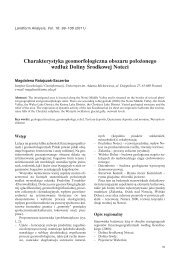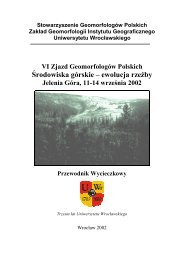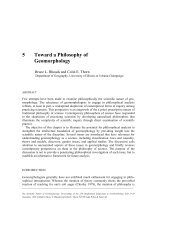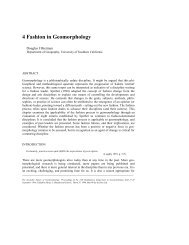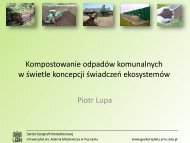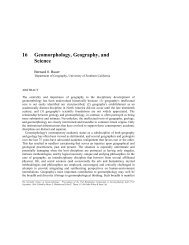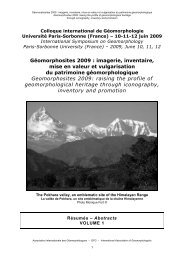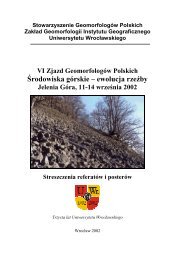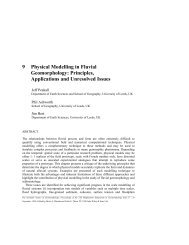Chapter 16 - Geomorphology, Geography, and Science Bernard 0
Chapter 16 - Geomorphology, Geography, and Science Bernard 0
Chapter 16 - Geomorphology, Geography, and Science Bernard 0
Create successful ePaper yourself
Turn your PDF publications into a flip-book with our unique Google optimized e-Paper software.
GEOMORPHOLOGY, GEOGRAPHY, AND SCIENCE 407<br />
their workings; to further dismantle these components into individual parts; to examine<br />
<strong>and</strong> describe those parts <strong>and</strong> their workings, <strong>and</strong> so on. Unfortunately, it is silent on<br />
methods of reassembly, <strong>and</strong> the essential chapter revealing to us what we truly seek - the<br />
internal workings of the Earth Machine - remains missing.<br />
Other disciplines, such as chemistry, astronomy, <strong>and</strong> physics, have begun to take steps<br />
toward reconstructive efforts. Schweber (1993, p. 34), for example, points out that 'the<br />
reductionist approach that has been the hallmark of theoretical physics in the 20th century<br />
is being superseded by the investigation of emergent phenomena, the study of properties<br />
of complexes whose "elementary" constituents <strong>and</strong> their interactions are known'. The term<br />
'emergent properties' refers, not to the theoretical or mathematical constructs that represent<br />
the fundamental laws which most reductionists seek, but rather, to the characteristic<br />
behavior of solutions to the mathematical expressions that describe natural phenomena.<br />
Recent research on nonlinear dynamical systems in geomorphology (e.g. Phillips 1992 <strong>and</strong><br />
references therein) seems particularly germane in this respect. The identification of<br />
emergent properties is not a straightforward task because it involves more than simple<br />
reconstruction (i.e. putting the deconstructed pieces together). This was recognized by<br />
Anderson (1972, p. 393) who suggested that:<br />
the more the elementary-particle physicists tell us about the nature of the fundamental laws,<br />
the less relevance they seem to have to the very real problems of the rest of science, much less<br />
to those of society ... The constructionist hypothesis breaks down when confronted with the<br />
twin difficulties of scale <strong>and</strong> complexity. The behavior of large <strong>and</strong> complex aggregates of<br />
elementary particles, it turns out, is not to be understood in terms of a simple extrapolation of<br />
the properties of a few particles.<br />
Anderson (1972) also argued that each scale level should have its own fundamental laws<br />
(i.e. its own ontology) <strong>and</strong> therefore, its own complexities <strong>and</strong> emergent properties.<br />
These ideas about distinctly different scale levels have found partial support in<br />
contemporary geomorphological practice (e.g. de Boer 1992; Sherman <strong>and</strong> Bauer 1993;<br />
Phillips 1995). At the smallest scales, it is not uncommon for scientists to favor concisely<br />
expressed, deterministic relations that invoke force balances or conservation principles (of<br />
mass, momentum, vorticity, entropy, or energy). At intermediate scales, much of the<br />
mathematical formality is retained, but some of the deterministic physics or chemistry are<br />
replaced by parameterizations that invoke phenomenological or constitutive coefficients<br />
such as conductivity, diffusivity viscosity, elasticity, erodibility, porosity, <strong>and</strong><br />
permeability, or the various coefficients of drag, friction, cohesion, <strong>and</strong> strength. These<br />
coefficients are used to relate the principal variables in a given process-response<br />
interaction when accounting for individual particles <strong>and</strong> their behavior is no longer<br />
possible. Ensemble averaging over domains of interest (representative elemental volumes)<br />
becomes necessary. At the largest scales, descriptions of system behavior usually assume<br />
probabilistic (indeterministic) properties or an idiographic <strong>and</strong> historical character. One of<br />
the challenges for geomorphologists, then, is to identify the existence <strong>and</strong> domain of these<br />
scale levels - their bounds, fundamental laws, <strong>and</strong> emergent properties.<br />
It is worth remembering, however, that some 'laws' may transcend scale in the sense<br />
that they will be characteristic of several contiguous levels. The law of gravity, for<br />
example, applies to most scales of geomorphological interest, as might the principles of<br />
least action, sufficient reason, <strong>and</strong> uniformity of nature (Yatsu 1992, p. 88). Geomorph-



